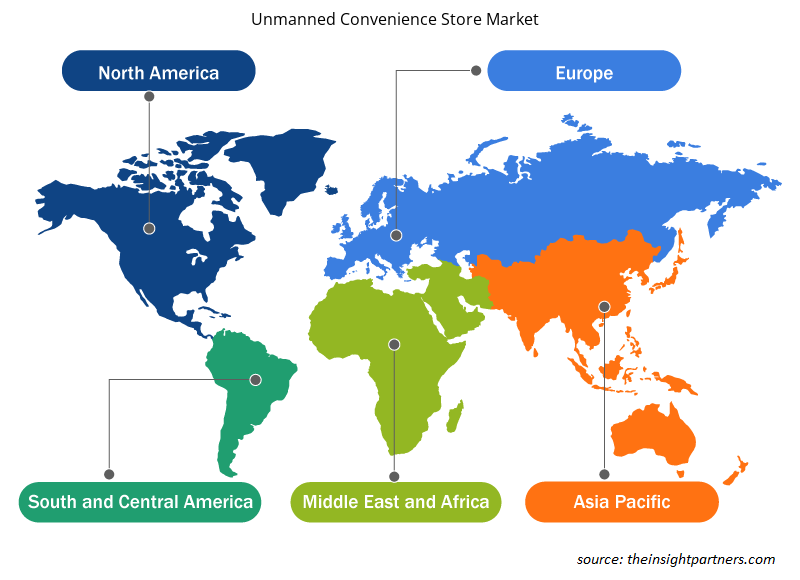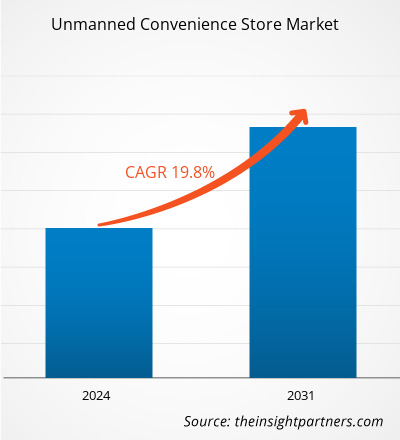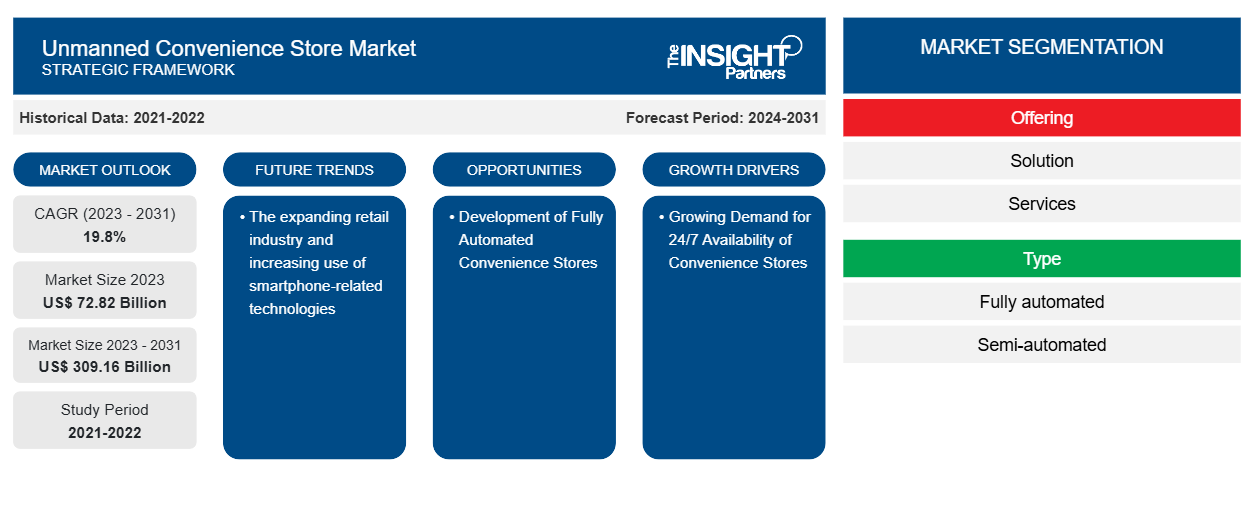无人便利店市场规模预计将从 2023 年的 728.2 亿美元增至 2031 年的 3091.6 亿美元。预计 2023-2031 年市场复合年增长率将达到 19.8%。零售业的不断扩张和智能手机相关技术的日益普及很可能仍是无人便利店市场的主要趋势。
无人便利店市场分析
随着人们对便利店24/7 服务的需求不断增长,以及消费者对购物便利性的需求不断增加,无人便利店市场正在快速增长。随着企业对通过提升消费者体验来优化成本的需求不断增加,市场正在稳步扩张。此外,技术进步和全自动便利店的发展为市场增长提供了有利可图的机会。
无人便利店市场概况
无人便利店是一种无需收银员、店内没有客服代表的零售店。这些商店使用人工智能和智能手机相关技术等先进技术来管理日常活动和交易。无人便利店旨在让消费者随时随地方便地购买快速消费品,如杂货或药品。然而,这些商店提供的显著优势,如全天候可用、便利、技术集成、自助服务和自助结账,以及为消费者服务提供商节省成本,推动了市场的发展。
定制此报告以满足您的需求
您可以免费定制任何报告,包括本报告的部分内容、国家级分析、Excel 数据包,以及为初创企业和大学提供优惠和折扣
-
获取此报告的关键市场趋势。这个免费样品将包括数据分析,从市场趋势到估计和预测。
无人便利店市场驱动因素和机遇
24/7便利店需求不断增长,推动市场发展
全球无人便利店行业正在不断扩张,因为人们对便利性和增强客户体验的需求日益增长。客户希望随时获得产品和服务,而不必排长队或前往实体店。这增加了无人便利店的需求和发展,以满足消费者的需求。无人便利店允许消费者 24 小时获得商品和服务,而无需工作人员在场即可满足这一需求。无人商店对公司来说是一种经济上有利的选择,因为它降低了支付员工工资的成本。预计这些因素将在预测期内提振市场。
全自动便利店的发展——无人便利店市场的机会
数字化程度的提高和企业对自主性的需求增加为市场创造了机会。采用自主运营的企业可以通过消除店内员工的实际存在来节省劳动力成本。这使公司能够集中精力并将其精力投入到其他领域,例如广告、产品代言和客户支持。自动化使无人便利店可以降低安全风险和保险费用。然而,对不易被盗或损坏的全自动便利店的需求和发展不断增长,为市场增长创造了巨大的机会。
无人便利店市场报告细分分析
有助于得出无人便利店市场分析的关键部分是产品和类型。
- 根据产品,无人便利店市场分为解决方案和服务。解决方案部分在 2023 年占据了更大的市场份额。
- 从类型上看,无人便利店市场分为全自动和半自动化两种,2023年全自动市场占有率较大。
无人便利店市场份额(按地区)分析
无人便利店市场报告的地理范围主要分为五个地区:北美、亚太、欧洲、中东和非洲、南美/南美和中美。
就收入而言,由于对非接触式购物体验和便利性的需求日益增长,北美市场占据了无人便利店的最大市场份额。北美市场受到越来越多地使用机器人和人工智能技术来实现结账流程自动化的推动。此外,移动支付方式的普及使消费者无需与收银员互动即可轻松购物,这推动了市场的发展。
无人便利店市场区域洞察
Insight Partners 的分析师已详尽解释了预测期内影响无人便利店市场的区域趋势和因素。本节还讨论了北美、欧洲、亚太地区、中东和非洲以及南美和中美洲的无人便利店市场细分和地理位置。

- 获取无人便利店市场的区域具体数据
无人便利店市场报告范围
| 报告属性 | 细节 |
|---|---|
| 2023 年的市场规模 | 728.2亿美元 |
| 2031 年市场规模 | 3091.6亿美元 |
| 全球复合年增长率(2023 - 2031) | 19.8% |
| 史料 | 2021-2022 |
| 预测期 | 2024-2031 |
| 涵盖的领域 |
通过奉献
|
| 覆盖地区和国家 |
北美
|
| 市场领导者和主要公司简介 |
|
无人便利店市场参与者密度:了解其对业务动态的影响
无人便利店市场正在快速增长,这得益于终端用户需求的不断增长,这些需求源于消费者偏好的不断变化、技术进步以及对产品优势的认识不断提高等因素。随着需求的增加,企业正在扩大其产品范围,进行创新以满足消费者的需求,并利用新兴趋势,从而进一步推动市场增长。
市场参与者密度是指在特定市场或行业内运营的企业或公司的分布情况。它表明相对于给定市场空间的规模或总市场价值,有多少竞争对手(市场参与者)存在于该市场空间中。
在无人便利店市场运营的主要公司有:
- 亚马逊公司(Amazon.com, Inc.)
- 深圳市远景达科技有限公司
- F5 未来商店
- 宾果盒
- CYB组织
- 7-Eleven 便利店
免责声明:上面列出的公司没有按照任何特定顺序排列。

- 了解无人便利店市场的主要参与者概况
无人便利店市场新闻及最新发展
无人便利店市场的评估是通过收集一手和二手研究后的定性和定量数据进行的,其中包括重要的公司出版物、协会数据和数据库。以下是无人便利店市场的发展和战略列表:
- 2024 年 2 月,7-Eleven Shop & Go 计划在东京等地开设无人便利店。这些无人便利店采用智能手机支付方式,以简化运营。(来源:日经新闻,新闻稿,2023 年)
无人便利店市场报告覆盖范围和交付成果
“无人便利店市场规模和预测(2021-2031)”报告对以下领域进行了详细的市场分析:
- 范围内所有主要细分市场的全球、区域和国家层面的市场规模和预测
- 市场动态,如驱动因素、限制因素和关键机遇
- 未来主要趋势
- 详细的 PEST/波特五力分析和 SWOT 分析
- 全球和区域市场分析涵盖关键市场趋势、主要参与者、法规和最新市场发展
- 行业格局和竞争分析,涵盖市场集中度、热点图分析、知名参与者和最新发展
- 详细的公司简介
- 历史分析(2 年)、基准年、预测(7 年)及复合年增长率
- PEST和SWOT分析
- 市场规模、价值/数量 - 全球、区域、国家
- 行业和竞争格局
- Excel 数据集
近期报告
客户评价
购买理由
- 明智的决策
- 了解市场动态
- 竞争分析
- 客户洞察
- 市场预测
- 风险规避
- 战略规划
- 投资论证
- 识别新兴市场
- 优化营销策略
- 提升运营效率
- 顺应监管趋势























 获取免费样品 - 无人便利店市场
获取免费样品 - 无人便利店市场